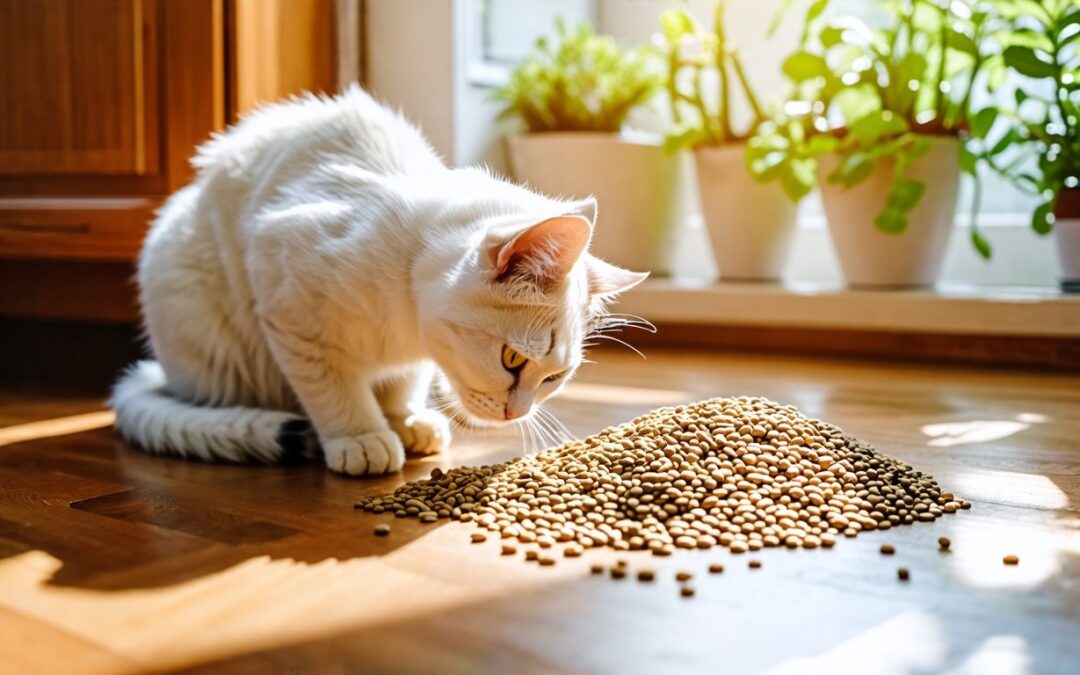Are you wondering if lentils can be a tasty treat for your furry friend? Lentils are not toxic to cats, making them a safe option to consider. This blog will guide you through the benefits and risks of adding lentils to your cat’s diet, ensuring they get nutritious meals that are right for them.
Keep reading to find out more!
Key Takeaways
- Cats are primarily meat-eaters and need animal protein to stay healthy, but they can safely eat lentils in small amounts. Lentils offer a good source of plant-based protein and other nutrients without adding too many calories to their diet.
- Too much lentil consumption can lead to risks like reduced nutrient absorption due to phytates and possible allergic reactions. It’s important to feed cats lentils carefully and watch for any signs of discomfort or health issues.
- Always cook lentils before giving them to your cat since raw lentils can contain substances harmful to them. Mashing or pureeing cooked lentils makes them easier for cats to digest.
- Before introducing lentils into your cat’s diet, it’s best to consult with a veterinarian. They can provide personalized advice based on your cat’s specific needs and health status, ensuring that the addition of lentils benefits rather than harms.
- When feeding cats lentils, moderation is key. Incorporating small portions into their meals alongside their regular animal protein intake can diversify their nutrition without compromising their dietary requirements.
What do Cats Normally Eat?
Cats primarily thrive on a diet rich in animal protein. Their bodies are designed to digest meat, making them obligate carnivores. Commercial cat food usually contains essential animal protein sources to meet their nutritional needs.
While some pet foods incorporate lentils and other legumes, these ingredients should not replace vital animal proteins that cats require.
Lentils are not naturally part of a feline diet but can provide certain benefits when included in moderation. Understanding what constitutes a healthy cat nutrition plan is crucial for any cat owner considering alternatives or additions to their pet’s meals.
Nutritional Value of Lentils for Cats
Lentils pack a protein punch and supply essential nutrients for cats. They also offer a low-calorie option, making them a tempting addition to your cat’s diet.
High in protein
Lentils are an excellent source of protein, which makes them appealing for many pet owners considering nutritious cat meals. They contain a high percentage of plant-based protein, making them a valuable addition to some commercial cat food recipes.
This protein is beneficial for cats, but it cannot replace the essential animal protein they need to thrive. Cats require specific amino acids found exclusively in animal sources.
While lentils contribute to a healthy diet and provide low-calorie options, they should only be fed in moderation. Including lentils as an ingredient can help diversify the types of nutrients your cat receives without overwhelming their digestive system with excessive legumes and phytates.
It is crucial that these additional foods do not compromise their primary intake of animal-derived proteins necessary for optimal health in cats.
Rich in nutrients
Lentils offer several nutritional benefits for cats. They are an excellent source of protein, providing a low-calorie option compared to many other foods. Rich in vitamins and minerals, lentils contribute additional nutrients that can be advantageous when included in a cat’s diet.
However, they cannot replace the essential animal protein that cats need for optimal health. This is crucial since felines require specific amino acids typically found in meat.
Cats can safely enjoy lentils in moderate amounts as part of their meals or treats. Understanding potential risks associated with legumes will help ensure a safe and healthy addition to your cat’s diet plan.
Low in calories
Lentils are low in calories, making them a suitable addition to certain cat food options. Including lentils in moderation can help maintain a healthy cat diet without contributing excessive calories.
However, they should never replace the essential animal protein that cats need for their overall health and well-being. As legumes, lentils provide beneficial nutrients while ensuring your feline friend stays within a balanced caloric intake.
Understanding how to safely incorporate lentils into your cat’s diet is crucial for their health.
Potential Risks of Feeding Lentils to Cats
Feeding lentils to cats can pose risks such as phytates, which might affect nutrient absorption, and potential allergies that could cause reactions. To understand these concerns better, explore more detailed information on this topic!
Phytates and legumes
Phytates are compounds found in many legumes, including lentils. These substances can bind to minerals and reduce their absorption in the body. While lentils provide high protein, fiber, and essential nutrients for cats, they also contain phytates that may pose challenges for some pets.
Cats primarily require animal proteins for optimal nutrition. Lentil consumption should remain moderate since these legumes cannot replace the essential amino acids found in meat.
Lentil allergies are another concern for some cats. Though not common, allergic reactions can occur with certain ingredients like legumes. Introducing new foods gradually helps monitor any adverse reactions to lentils or other ingredients in pet food recipes.
A veterinarian’s advice is crucial before adding lentils or any non-traditional food items into a cat’s diet to ensure safety and health.
Possible lentil allergies
Lentils can potentially trigger allergies in some cats. While they are not toxic, lentil allergies might cause digestive upset or skin reactions. Cats have specific dietary needs, and new ingredients like legumes can lead to unexpected responses.
If your cat shows signs of discomfort after consuming lentils, discontinue feeding them immediately. Always consult with a veterinarian before introducing new foods into your cat’s diet to ensure their health and safety regarding grainfree options and pet food ingredients.
How to Safely Incorporate Lentils into Your Cat’s Diet
To safely add lentils to your cat’s diet, start with small amounts and choose the right cooking method, while always checking with your veterinarian for guidance. Keep exploring for more tips on keeping your furry friend healthy!
Moderation is key
Feeding lentils to cats should always be done in moderation. While lentils are not toxic to cats and can offer some nutritional benefits, they cannot replace the essential animal protein that felines require.
Lentils contain good amounts of protein, fiber, and minerals but also come with phytates, which may interfere with nutrient absorption. A small percentage of dry cat food includes ingredients like lentils or peas for added nutrition; however, these should complement a diet primarily made up of meat-based proteins.
Lentil consumption for cats can be beneficial if kept within safe limits. Cats thrive on animal protein sources that provide essential amino acids necessary for their health. Therefore, incorporating small portions of lentils into your pet’s meals is acceptable as long as it does not overshadow their primary need for high-quality animal proteins found in commercial cat food recipes.
Always keep an eye on how your cat responds to any new foods introduced into their diet.
Best form to feed lentils
Cooked lentils are the best form to feed cats. Raw lentils may contain harmful substances that could cause digestive issues. Cooking breaks down these components, making them safer for feline consumption.
Lentils should be mashed or pureed to facilitate easier digestion for your cat. It’s essential to introduce them in moderation alongside their regular diet of animal protein.
Some commercial cat foods include lentils as an ingredient, which can offer a safe option. Always consult with a veterinarian before adding any new foods to ensure they’re suitable for your pet’s specific needs.
Proceeding with caution helps avoid potential allergies and ensures your furry friend stays healthy while exploring safe foods for cats.
Consult with a veterinarian
Feeding lentils to cats can be a bit tricky. While they are not toxic to cats, it’s important to consult with a veterinarian before making changes to their diet. A vet can provide guidance on incorporating lentils safely and ensure that your cat’s nutritional needs are being met.
This is especially crucial since lentils cannot replace essential animal protein needed for proper health.
Veterinarians can help you determine the right amount of lentils if you choose to add them into your cat’s meals. They will consider factors like age, weight, and any existing health conditions.
Professional advice is vital as some cats may have allergies or sensitivities, which means that monitoring food intake becomes even more important in preventing any adverse reactions.
Conclusion
Cats can enjoy lentils in moderation. These legumes provide some protein and nutrients but cannot replace essential animal proteins. Always monitor your cat’s reaction when introducing new foods.
A quick chat with your veterinarian ensures a balanced diet for your furry friend. That way, you keep mealtime safe and enjoyable for them!
FAQs
1. Can cats eat lentils?
Cats can technically eat lentils, but it’s not recommended as a main part of their diet due to potential toxicity issues.
2. Are there risks involved with feeding cats lentils?
Yes, excessive consumption of lentils could lead to lentil toxicity in cats which may cause digestive problems.
3. How does grain-free pet food relate to legumes and cats?
Grain-free pet food often uses legumes like lentils instead of cereal grains, but they might not be the best choice for your cat’s nutrition needs.
4. Is it better to feed my cat cereal grains or legumes like lentils?
While some owners opt for grain-free diets for their pets, both cereal grains and legumes have pros and cons; consulting with a vet is the best course of action.






